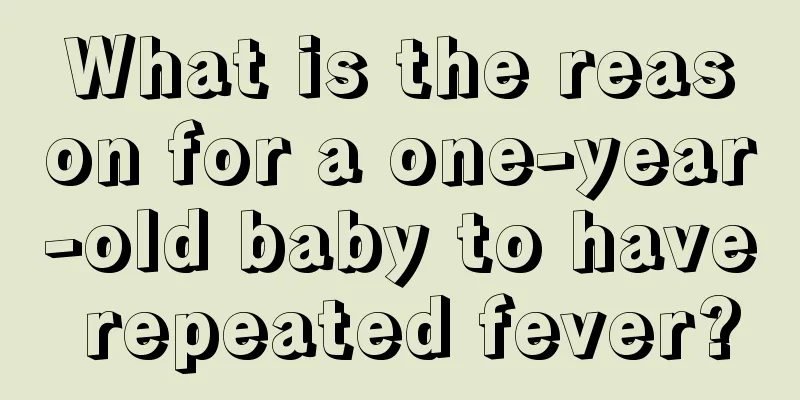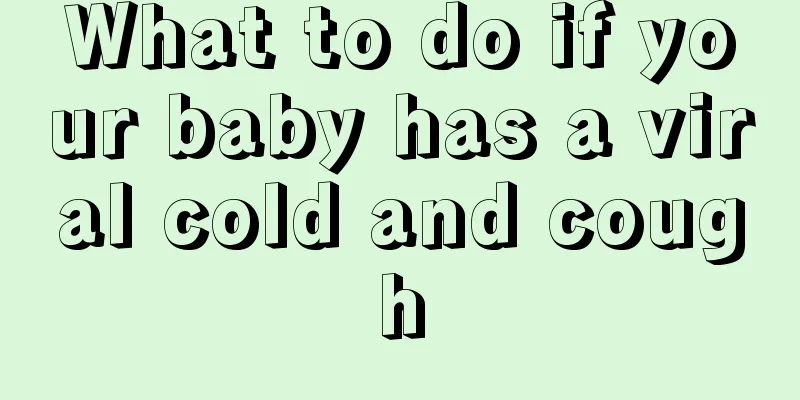What is the reason for a one-year-old baby to have repeated fever?

|
One-year-old babies are very prone to fever. There are many reasons for fever, which are largely related to their diet, personal constitution, and parents' preventive measures. However, some one-year-old babies are very prone to repeated fevers. The fever recurs just after treatment, which is very worrying for parents. So what is the reason for the repeated fever of one-year-old babies? There is not a single factor that causes recurrent fever, and it is related to factors such as care methods, diet, personal constitution, and preventive measures. The normal human rectal temperature is 36.5-37.5°C, the oral temperature is 37.0°C, and the axillary and neck temperature is 36-37°C. When the body temperature is lower than 38.5°C, physical cooling methods can be used first, such as using a cooling patch, taking a warm bath, etc. You need to give your baby medication as directed by your doctor. If the high fever persists, you still need to see a doctor again. What the mother needs to pay attention to now is to let the baby drink more water, rest, and measure the body temperature regularly. If your baby has a fever, it is recommended to take him for a blood test to see if it is caused by a viral infection or a bacterial infection. Simply using antipyretic drugs will not work.Guidance: It is recommended to use cefuroxime granules and ribavirin for treatment. At the same time, you can use Anruik to reduce fever. Drink more water and use medical alcohol to physically cool down various parts of the baby's body. Fever reduction method: Maintain good air circulation at home: If your home has air conditioning, maintain the room temperature between 25 and 27 degrees Celsius. You can place the child in an air-conditioned room or blow an electric fan around him to slowly lower his body temperature, which will make the child feel more comfortable. But if the limbs are cold and the patient is shivering violently, it means that the patient needs warmth, so he should be covered with a blanket. Take off too many clothes: If your baby's limbs and hands and feet are warm and he is sweating all over, it means he needs to dissipate heat and he can wear less clothes. Warm water bath: Undress the baby and rub the whole body with a warm water (37℃) towel. This will dilate the blood vessels in the baby's skin and release body qi. In addition, when water vapor evaporates from the body surface, it will also absorb body heat.Sleeping with an ice pillow: It helps to dissipate heat, but it is not recommended for younger infants because it is difficult for them to turn their bodies and an ice pillow can easily cause local overcooling or hypothermia. You can also use a cooling patch. When the water in the gelatinous substance of the cooling patch evaporates, it can take away the heat and will not cause excessive cooling. Drink plenty of water: to help sweating and prevent dehydration. Water has the function of regulating temperature, which can lower body temperature and replenish water lost in the baby's body. Use antipyretics: When the core temperature (rectal temperature or ear temperature) of an infant or young child exceeds 38.5°C, antipyretic solutions or suppositories can be used appropriately. |
<<: What should I do if my baby walks unsteadily after having a fever?
>>: Why do babies often have fever?
Recommend
What are the treatments for keratitis in children?
Generally speaking, after children suffer from ke...
Why are baby teeth yellow?
Infants and young children will grow deciduous te...
You can tell if your baby is smart by looking at his sleeping position.
We all know that many babies curl up their bodies...
Children's skin allergy red pimples
Sometimes, parents will find that their children ...
Children's skin itchy wheals
We all know that children's physical fitness ...
What to do if your child has a cold or bacterial infection
There are two types of colds in children. One is ...
How to promote bone development in boys?
Boys' bone development is relatively importan...
What to do if your child has separation anxiety?
Different parents will take different approaches ...
What are the causes of deformities in children?
Every mother wants to give birth to a healthy bab...
Why does the baby's fontanelle close late and how to deal with it
I believe every parent is very concerned about th...
What to do if your three-year-old baby gets chickenpox
Varicella is a relatively common infectious skin ...
Is it a disease if a baby shakes his head while sleeping?
Baby sleep problems are a stubborn problem that t...
Introduction to the latest treatments for cerebral palsy in children
Cerebral palsy in children is a disease that many...
What are the methods for breast enhancement for adolescent girls?
Adolescence is a developmental process. Our bodie...
Can children eat watermelon when they have a cough?
Children’s physical health has always been a matt...









